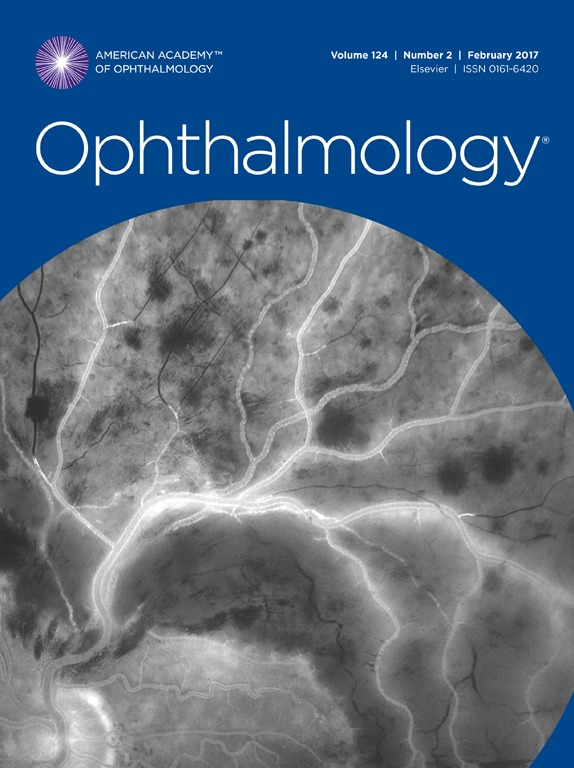Special Commentary: Reporting Clinical Endpoints in Studies of Minimally Invasive Glaucoma Surgery
IF 13.1
1区 医学
Q1 OPHTHALMOLOGY
引用次数: 0
Abstract
Minimally invasive glaucoma surgery (MIGS) refers to a group of procedures generally characterized by an ab interno approach, minimal trauma to ocular tissue, moderate efficacy, an excellent safety profile, and rapid recovery. The number of MIGS procedures continues to increase, and their use has become widespread among glaucoma and cataract specialists. Standardization of the methodology and reporting of clinical endpoints in MIGS investigations enhances interpretation and comparison across different studies. The assessment of surgical interventions not only should consider statistical significance, but also whether the outcome is meaningful to patients. Minimal clinically important difference (MCID) is defined as the smallest change in a treatment outcome that is considered beneficial for an individual patient and prompts a change in their clinical management. Expert consensus is an accepted approach to determine the MCID. The American Academy of Ophthalmology’s Glaucoma Preferred Practice Pattern® Committee is an expert panel that develops guidelines identifying characteristics and components of quality eye care. The Committee recommends that the cumulative probability of surgical success at 2 years with Kaplan–Meier survival analysis be used as the primary efficacy endpoint in MIGS studies. The Committee suggests that surgical success for standalone MIGS be defined as intraocular pressure (IOP) of 21 mmHg or less and reduced by 20% or more from baseline without an increase in glaucoma medications, additional laser or incisional glaucoma surgery, loss of light perception vision, or hypotony. The proposed MCID for the cumulative probability of success of standalone MIGS at 2 years is 50%. The panel recommends that surgical success for MIGS combined with cataract extraction with intraocular lens implantation (CE-IOL) be defined as a decrease in glaucoma medical therapy of 1 medication or more from baseline without an increase in IOP or IOP of 21 mmHg or less and reduced by 20% or more from baseline without an increase in glaucoma medications, additional laser or incisional glaucoma surgery, loss of light perception vision, or hypotony. The suggested MCID for the cumulative probability of success for MIGS combined with CE-IOL at 2 years is 65%.
Financial Disclosure(s)
Proprietary or commercial disclosure may be found in the Footnotes and Disclosures at the end of this article.
在微创青光眼手术研究中报告临床终点。
微创青光眼手术(MIGS)指的是一组手术,其一般特点是采用室内方法,对眼部组织的创伤最小,疗效适中,安全性高,恢复迅速。MIGS 手术的数量不断增加,在青光眼和白内障专科医生中已得到广泛应用。MIGS 研究方法和临床终点报告的标准化有助于不同研究之间的解释和比较。手术干预的评估不仅要考虑统计意义,还要考虑结果是否对患者有意义。最小临床意义差异(MCID)被定义为治疗结果中对个体患者有益并促使其改变临床管理的最小变化,专家共识是确定 MCID 的公认方法。美国眼科学会青光眼首选实践模式小组是一个专家小组,负责制定指导方针,确定优质眼科护理的特征和组成部分。该小组建议,在 MIGS 研究中,使用 Kaplan-Meier 生存分析法将 2 年后手术成功的累积概率作为主要疗效终点。专家小组建议,独立 MIGS 的手术成功定义为眼压 (IOP) ≤ 21 mmHg 且比基线降低≥ 20%,且未增加青光眼药物、未进行额外的激光或切口青光眼手术、未丧失光感视力或眼睑下垂。建议独立 MIGS 2 年的累积成功概率 MCID 为 50%。专家小组建议,MIGS 联合白内障摘除术与眼内人工晶体植入术(CE-IOL)的手术成功定义为:青光眼药物治疗比基线减少≥ 1 种药物且眼压未增加,或眼压≤ 21 mmHg 且比基线减少≥ 20%,且未增加青光眼药物、额外的激光或切口青光眼手术、光感视力丧失或眼压过低。CE-IOL/MIGS 2 年的累积成功概率的建议 MCID 为 65%。
本文章由计算机程序翻译,如有差异,请以英文原文为准。
求助全文
约1分钟内获得全文
求助全文
来源期刊

Ophthalmology
医学-眼科学
CiteScore
22.30
自引率
3.60%
发文量
412
审稿时长
18 days
期刊介绍:
The journal Ophthalmology, from the American Academy of Ophthalmology, contributes to society by publishing research in clinical and basic science related to vision.It upholds excellence through unbiased peer-review, fostering innovation, promoting discovery, and encouraging lifelong learning.
 求助内容:
求助内容: 应助结果提醒方式:
应助结果提醒方式:


